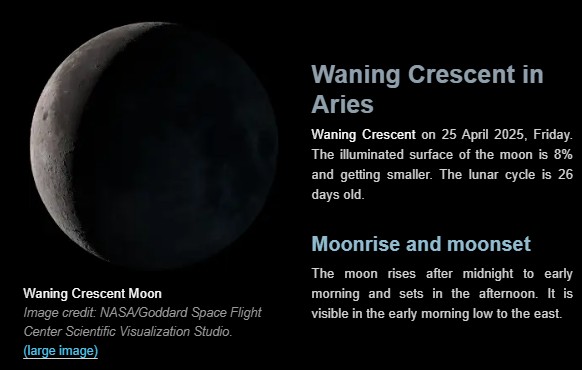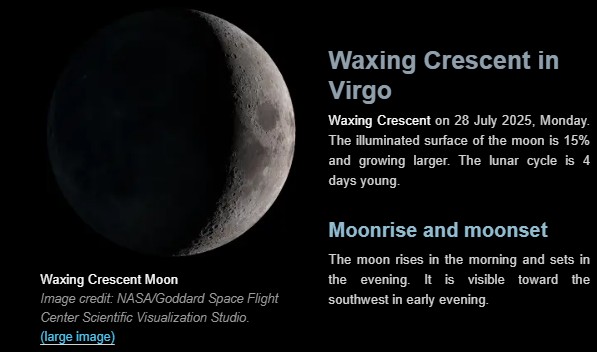Moon Phase on April 25, 2025
The Moon, in its endless dance around Earth, shapes our nights and connects us to ancient rhythms. On April 25, 2025, the Moon will show its Waning Crescent phase, a subtle and beautiful sliver of light that graces the western sky just before sunrise. This delicate phase captures the attention of those who look up early in the morning, as the thin crescent hangs like a quiet promise of the New Moon to come.
The Waning Crescent belongs to the last quarter of the lunar cycle—a slow fading of illumination that invites reflection and prepares us for a fresh start in the lunar calendar. Its fragile curve is more than a pretty sight; it opens a unique window into lunar geology and marks transitions in both skywatching and natural phenomena.

Understanding the Waning Crescent Phase
The Waning Crescent is the Moon’s final phase before it disappears entirely during the New Moon. The light we see comes from the Sun’s rays reflecting off the Moon’s surface, but during this phase, most of that surface is in shadow.
Why is Illumination So Low?
The Moon is positioned almost between the Earth and the Sun, with its illuminated side pointing away from us. This means we only catch a glimpse of a narrow crescent of sunlit surface. The rest remains cloaked in darkness or hidden by the lunar horizon.
The waning shape signals that the Moon’s journey is nearing a reset. Each night, the crescent gets thinner, shrinking until it vanishes, making way for the New Moon—a time when the sky is darkest.
Lunar Illumination and Age on April 25, 2025
On this specific day, the Moon will have around 7 to 8.5% illumination, which means it’s a very slim crescent. The Moon’s age is about 27 days, nearly at the end of its approximately 29.5-day cycle.
This limited illumination makes the Moon less bright but more intriguing for observers who want to catch details along the line between light and dark, known as the terminator.
Visibility and Best Time to View
The Waning Crescent on April 25 is best viewed just before sunrise, hanging low in the western sky. Observing at this time offers the greatest contrast along the terminator, where shadows stretch long over craters and mountain peaks.
These shadows cast by the low angle of sunlight reveal textures and features often invisible during fuller phases. The thin crescent becomes a fleeting canvas of lunar topography, inviting binoculars or small telescopes for a closer look.
Moon’s Position in the Zodiac on April 25, 2025
On this day, the Moon will lie in the zodiac sign of Pisces, approximately 19.75° into the constellation. This positioning affects the Moon’s path and timing in the sky, crossing the ascending node and moving from south to north relative to the ecliptic plane.
Its journey through Pisces aligns with the early morning appearance in the west and influences how observers experience the lunar phase at that location in the sky.
Astronomical and Cultural Significance of the Moon Phase on April 25, 2025
The Waning Crescent isn’t just a scientific point—it carries meaning in how humans and nature have interacted with lunar cycles through history.
Scientific Observation Opportunities
With low illumination, the Moon becomes an excellent target for examining its surface features. The long shadows cast near the terminator highlight craters, ridges, and valleys more dramatically than during a full or gibbous Moon.
Astronomers and lunar enthusiasts use this phase to study lunar geology. The subtle light helps map surface structures and identify details that are otherwise washed out by bright sunlight.
Historical and Cultural Impact
Many ancient cultures used the Waning Crescent phase to mark the last days of the lunar month. This phase often signaled times for rest, reflection, and preparation for renewal.
Traditional agricultural calendars sometimes tied planting schedules or festivals to the Moon’s phases. The fading Moon reminded farmers to conclude certain tasks while anticipating the fertility and growth associated with the New Moon’s arrival.
Practical Implications for Modern Applications
Beyond tradition, the Waning Crescent phase influences tides with its unique gravitational pull. Around this time, neap tides occur—when tidal differences between high and low tide are less extreme, affecting coastal regions and marine activities.
For space missions, the waning light offers better conditions for landing site observations and surface imaging. In energy production, especially tidal energy, understanding the Moon phase helps predict tidal flows crucial for reliable operation.
Upcoming Lunar Phases Around April 25, 2025
The Moon is on the verge of a reset. After April 25, the crescent continues to shrink, leading quickly to the New Moon on April 28.
Transition to the New Moon
In the days following April 25, the illuminated part of the Moon continues to decrease, retreating into invisibility from Earth’s perspective. This transition marks the end of one lunar cycle and the quiet start of another.
The New Moon phase is a moment of darkness in the night sky—the Moon’s illuminated surface turns away completely, leaving only stars and planets to shine.
Impact on Night Sky and Observing Conditions
Once the New Moon arrives, especially after April 28, the night sky turns darker. Without moonlight, stars appear sharper and more numerous, making the nights ideal for stargazing and astrophotography.
For professional astronomers, the absence of lunar glare improves the visibility of faint objects, helping gather clearer data.
Conclusion
The Moon phase on April 25, 2025 offers a rare chance to witness the lunar cycle’s subtle shift toward renewal. The Waning Crescent’s thin glow, around 7 to 8.5% illumination, highlights the Moon’s rugged surface with intricate shadows, best seen just before dawn in the western sky.
This phase is more than a scientific moment—it ties human culture, nature’s rhythms, and cosmic mechanics into one fragile curve of light. Watching this delicate crescent reminds us of the ongoing cycles that shape time, tides, and the night sky.
Set your alarm, step outside before sunrise, and look west. That fragile sliver of the Moon on April 25, 2025 invites you to pause, observe, and connect with the quiet turning of lunar time.
